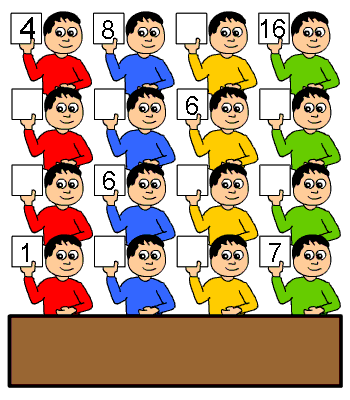Or search by topic
Number and algebra
Geometry and measure
Probability and statistics
Working mathematically
Advanced mathematics
For younger learners
Carrying Cards



- Problem
- Getting Started
- Student Solutions
- Teachers' Resources
Carrying Cards
These sixteen children are standing in four lines of four, one behind the other. They are each holding a card with a number on it.

Why do this problem?
This problem will give pupils experience of looking for, and explaining, number patterns, and it could lead into algebra. It would also make a good introduction to spreadsheet use.
Possible approach
You could introduce this problem practically in the classroom with children holding small whiteboards, for example. Rather than wearing coloured shirts, the children could have particular coloured pens or they might wear 'bibs' or ribbons usually used for sports matches. Arrange the sixteen children in four rows of four as in the picture and write the given numbers on the appropriate whiteboards. Once the problem has been introduced in this way, the sixteen children can return to their seats and the whole class can discuss the challenge. Learners should be given time to talk to each other in pairs or small groups as well as discussing the problem as a whole class.
Key questions
Possible extension
Possible support
You may also like
Chocolate
There are three tables in a room with blocks of chocolate on each. Where would be the best place for each child in the class to sit if they came in one at a time?
Four Triangles Puzzle
Cut four triangles from a square as shown in the picture. How many different shapes can you make by fitting the four triangles back together?
Cut it Out
Can you dissect an equilateral triangle into 6 smaller ones? What number of smaller equilateral triangles is it NOT possible to dissect a larger equilateral triangle into?

